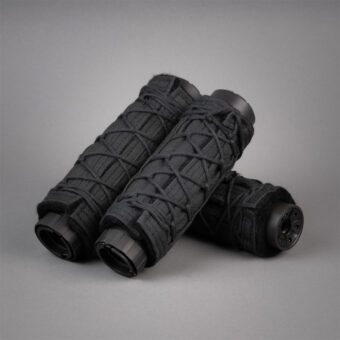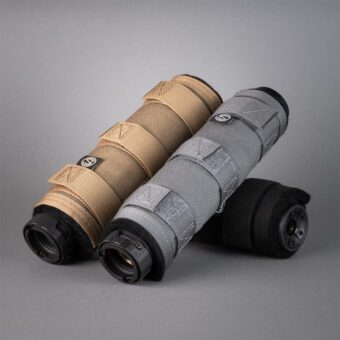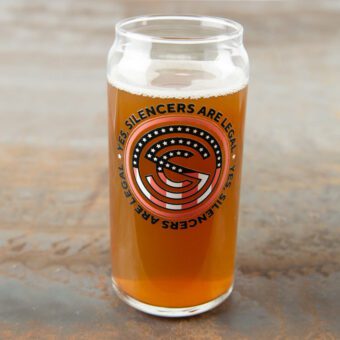Home / Silencer & Gun News / Arsenal Blog 004: Steyr AUG
Arsenal Blog 004: Steyr AUG
Home / Silencer & Gun News / Arsenal Blog 004: Steyr AUG
Arsenal Blog 004: Steyr AUG
SILENCERCO’S ARSENAL SERIES showcases guns we love for various reasons that reside in our in-house Arsenal. While we are best-known for making guns quiet, in order to do so we interact with a great variety of amazing platforms. In these posts we will tell you about each platform we like, why it’s different and relevant, and why we think it belongs in our pantheon of greatness.
Austrian gun manufacturer Steyr-Daimler-Puch began development of the Steyr AUG (Armee-Universal-Gewehr or Universal Army Rifle) in the 1960’s. The driving force for the development of this rifle was NATO’s transition from the 7.62x51mm NATO caliber to 5.56x45mm NATO. The Austrian army had previously been using the Stg 58, also known as the FN FAL. The AUG was completed in 1977 and then adopted by the Austrian military as the StG 77.
The AUG features a bullpup design which relocates the action of the rifle behind the trigger mechanism. This design moves the greatest portion of the mass of the rifle close the operator’s body, which reduces fatigue and increases the speed with which the weapon can be brought up to engage targets. The other definitive advantage to a bullpup design is the decrease in overall length of the rifle without having to reduce the length of the barrel from its 20 optimal length, which allows the AUG to take full advantage of the 5.56x45mm cartridge. The combination of short overall length and long barrel make it incredibly versatile on the battlefield.
A common misconception is that the Steyr AUG was the first bullpup assault rifle. It was, however, the first bullpup design to be the standard issue rifle for multiple countries. One reason for this success is that the designers at Steyr borrowed features and ideas from other battle-tested rifles such as the British Enfield EM-2 and the Soviet Korobov TKB-022. The EM-2 featured a bullpup configuration and integrated optical sighting system. The TKB-022 was a bullpup configuration with a polymer frame. By combining these design elements, Steyr put together a cohesive package that looked good, shot even better, and wouldn’t stop.
One of the AUG’s most unique features is the modularity of its design which gives the user the ability to configure his system for the specific mission and role. The receiver was designed in such a way that the barrel and receiver are easily separated, meaning the user had at his disposal an array of barrel lengths including 13.8, 16, 20, and a heavy barrel.
The AUG A1 features an integrated 1.5x optical sight made by Swarovski, the body of which is aluminum and is cast directly to the receiver. The original reticle features a black circle nicknamed The Donut of Death. This unique reticle was ballistically matched to the NATO 5.56mm cartridge so that if the target you were aiming at was within the circle from 0-300 meters, there would be an impact on target; if a standing man fit inside the circle he was approximately 300 meters away. Later in the AUG’s service life, other reticles became available. The scope also includes a set of iron sights cast into the scope body for close encounters within 100 meters.
The select fire AUG features a progressive trigger that allows the shooter to take semi-automatic shots by pulling the trigger past the first wall and then releasing the trigger. For full-auto fire, the shooter pulls through the extent of the trigger’s travel pinning it to the rear. This feature removed the need for multiple selection positions.
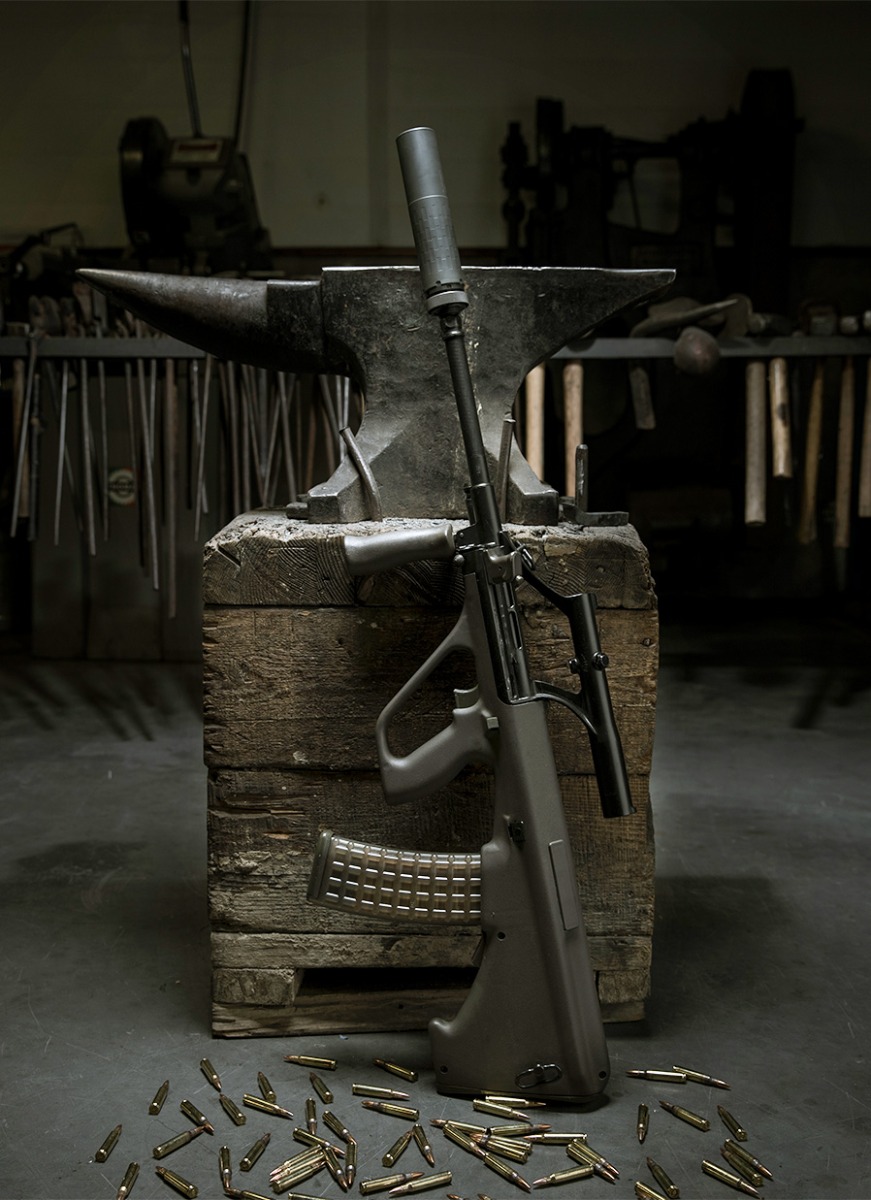
Things We Like
Configurable for right- and left-handed shooters: One of the challenges with most bullpup designs is that they put the ejection port next to a left-handed shooter’s face. The AUG overcomes this issue by including the ability to eject spent brass to either the right or left side. This is accomplished by first changing out the bolt to have the extractor and ejector plunger in the correct orientation to eject rounds out the desired side and then moving the ejection port cover to the opposite port.
Quick and easy remedial action to clear malfunctions: Remedial actions to clear many malfunctions call for the removal of the barrel to allow the jam to be cleared, and since the barrel and receiver can be easily separated within seconds, this is accomplished with ease. Most remedial actions on similar platforms take much longer to clear and have many more steps than the AUG.
Easy disassembly of all critical rifle components for cleaning and inspection: The modular design is advantageous when it comes to cleaning and maintenance. The removable barrel allows for full access to clean and inspect the chamber without having to deal with a barrel extension like in the M4. The shooter also as easy access to clean the locking recess for the bolt as well as the guide bushing for the operating rods for the bolt. The trigger pack is easily removed for cleaning with compressed air or by inserting a brush through the butt stock to push the trigger pin retaining button, pushing the pin out of the stock, and removing the butt pad so the trigger pack slides out.
Tools built into the rifle for gas piston disassembly: In order to remove the gas piston from the gas cylinder on the barrel, the shooter must push the piston back through the opening created by removing the gas regulator. The right operating rod in the bolt carrier assembly has the end turned down to the correct diameter to enable you to push the piston out along with the piston return spring. This is particularly advantageous because it means one less thing a shooter has to worry about packing with him.
Things We Don’t Like
Adjusting the gas system for different conditions is cumbersome: The AUG operates by using a short stroke gas system with three positions: normal conditions, fouled, and grenades. These settings are changed by sliding a spring-loaded detent out of the notches around the circumference of the gas cylinder and then rotating the piston to the desired setting. This operation becomes difficult with gloved, dirty, or cold hands or at night and is potentially harmful as the weapon becomes hot from long strings of fire.
Awkwardness of prone firing: The 42-round magazine length is considerably longer than a traditional 30-round magazine, which makes it necessary for a shooter to raise his body further off the ground to align himself for accurate and precise shooting. With the magazine located at the rear of the firearm, the user experiences an undesirable tendency for the muzzle to dip.
No bolt release button: The AUG has a non-reciprocating charging handle on the left-hand side of the receiver. When the magazine is empty, the bolt is held open. After inserting a new magazine, the operator must pull the charging handle all the way back from its forward locked position to remove pressure from the bolt stop to allow the bolt to travel forward. There is no convenient bolt release button to drop the bolt once a magazine change has occurred, and the angle at which that the charging handle protrudes from the receiver puts it awkwardly close to the risers from the receiver to the scope body.
Scope requires special tool to adjust: The integrated scope does feature adjustment screws for elevation and windage that are uncapped but require a special tool to be adjusted. This is in contrast to the majority of scopes at the time that featured capped turrets with a slot that would accept anything from a coin to the rim of a cartridge to rotate them, or turrets that were knurled to allow toolless adjustment.
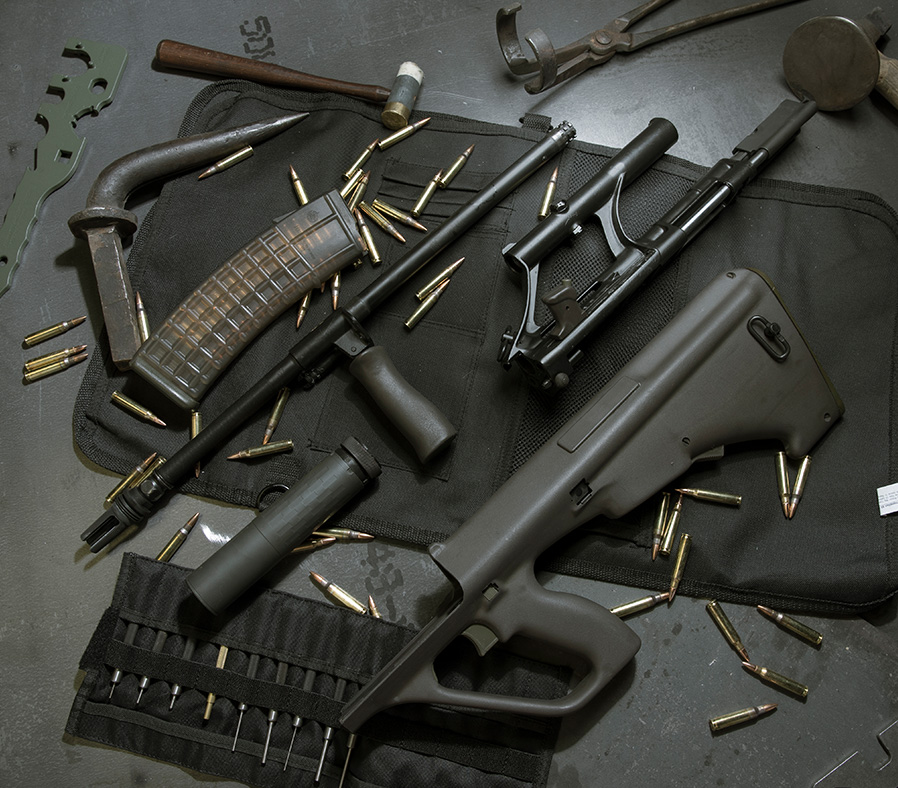
Conclusion
Overall, we love the AUG’s futuristic good looks, ease of maintenance, compact package, and modularity and we find it always makes an afternoon of silencer testing a little more enjoyable.
NEXT UP: The American 180 The only .22LR machine gun ever issued for use by a state agency (the Utah Department of Corrections). This lightweight, high rate of fire platform draws its lineage from WWI Lewis guns with a top-mounted rotary magazine and a few more tricks up its sleeve that we’re excited to share.






